#lithium battery testing system
Explore tagged Tumblr posts
Text

Semco SLB 5V 3A 8CH is an 8-channel pouch cell tester designed for precise lithium-ion battery analysis. Widely used in battery R&D and production for its reliability, speed, and smart control.
#Semco SLB 5V 3A 8CH#8CH pouch cell tester#lithium-ion battery tester#battery testing equipment#pouch cell testing machine#lithium battery testing system#multi-channel battery tester#5V 3A battery tester#battery R&D equipment#precision battery tester
0 notes
Text
Good News - June 8-14
Like these weekly compilations? Tip me at $Kaybarr1735! And if you tip me and give me a way to contact you, at the end of the month I'll send you a link to all of the articles I found but didn't use each week!
1. Rare foal born on estate for first time in 100 years

“The Food Museum at Abbot's Hall in Stowmarket, Suffolk, is home to a small number of Suffolk Punch horses - a breed considered critically endangered by the Rare Breeds Survival Trust. A female foal was born on Saturday and has been named Abbots Juno to honour the last horse born at the museum in 1924. [...] Juno is just one of 12 fillies born so far this year in the country and she could potentially help produce more of the breed in the future.”
2. The cement that could turn your house into a giant battery

“[Scientists] at Massachusetts Institute of Technology (MIT) have found a way of creating an energy storage device known as a supercapacitor from three basic, cheap materials – water, cement and a soot-like substance called carbon black. [... Supercapacitators] can charge much more quickly than a lithium ion battery and don't suffer from the same levels of degradation in performance. [... Future applications of this concrete might include] roads that store solar energy and then release it to recharge electric cars wirelessly as they drive along a road [... and] energy-storing foundations of houses.”
3. New road lights, fewer dead insects—insect-friendly lighting successfully tested

“Tailored and shielded road lights make the light source almost invisible outside the illuminated area and significantly reduces the lethal attraction for flying insects in different environments. [...] The new LED luminaires deliver more focused light, reduce spill light, and are shielded above and to the side to minimize light pollution. [... In contrast,] dimming the conventional lights by a factor of 5 had no significant effect on insect attraction.”
4. When LGBTQ health is at stake, patient navigators are ready to help

“[S]ome health care systems have begun to offer guides, or navigators, to get people the help they need. [... W]hether they're just looking for a new doctor or taking the first step toward getting gender-affirming care, "a lot of our patients really benefit from having someone like me who is there to make sure that they are getting connected with a person who is immediately going to provide a safe environment for them." [... A navigator] also connects people with LGBTQ community organizations, social groups and peer support groups.”
5. Tech company to help tackle invasive plant species

“Himalayan balsam has very sugary nectar which tempts bees and other pollinators away from native plants, thereby preventing them from producing seed. It outcompetes native plant species for resources such as sunlight, space and nutrients. [...] The volunteer scheme is open to all GWT WilderGlos users who have a smartphone and can download the Crowdorsa app, where they can then earn up to 25p per square meter of Balsam removed.”
6. [Fish & Wildlife] Service Provides Over $14 Million to Benefit Local Communities, Clean Waterways and Recreational Boaters
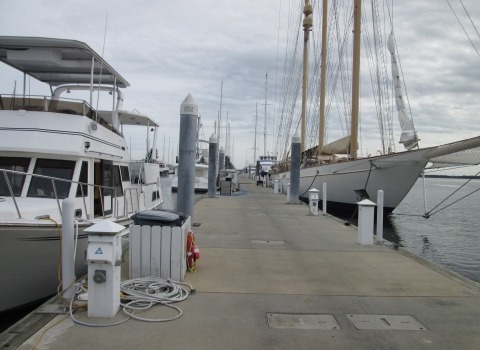
“The U.S. Fish and Wildlife Service is distributing more than $14 million in Clean Vessel Act grants to improve water quality and increase opportunities for fishing, shellfish harvests and safe swimming in the nation’s waterways. By helping recreational boaters properly dispose of sewage, this year’s grants will improve conditions for local communities, wildlife and recreational boaters in 18 states and Guam.”
7. Bornean clouded leopard family filmed in wild for first time ever

“Camera traps in Tanjung Puting National Park in Indonesian Borneo have captured a Bornean clouded leopard mother and her two cubs wandering through a forest. It's the first time a family of these endangered leopards has been caught on camera in the wild, according [to] staff from the Orangutan Foundation who placed camera traps throughout the forest to learn more about the elusive species.”
8. Toy library helps parents save money 'and the planet'

“Started in 2015 by Annie Berry, South Bristol's toy library aims to reduce waste and allow more children access to more - and sometimes expensive - toys. [...] Ms Berry partnered with the St Philips recycling centre on a pilot project to rescue items back from landfill, bringing more toys into the library. [...] [P]eople use it to support the environment, take out toys that they might not have the space for at home or be able to afford, and allow children to pick non-gender specific toys.”
9. Chicago Receives $3M Grant to Inventory Its Trees and Create Plan to Manage City’s Urban Forest

“The Chicago Park District received a $1.48 million grant [“made available through the federal Inflation Reduction Act”] to complete a 100% inventory of its estimated 250,000 trees, develop an urban forestry management plan and plant 200 trees in disadvantaged areas with the highest need. As with the city, development of the management plan is expected to involve significant community input.”
10. Strong Public Support for Indigenous Co-Stewardship Plan for Bears Ears National Monument

“[The NFW has a] plan to collaboratively steward Bears Ears National Monument to safeguard wildlife, protect cultural resources, and better manage outdoor recreation. The plan was the result of a two-year collaboration among the five Tribes of the Bears Ears Inter-Tribal Coalition and upholds Tribal sovereignty, incorporates Traditional Ecological Knowledge, and responsibly manages the monument for hunting, fishing, and other outdoor recreation while ensuring the continued health of the ecosystem.”
June 1-7 news here | (all credit for images and written material can be found at the source linked; I don’t claim credit for anything but curating.)
#hopepunk#good news#nature#horse#rare breed#energy storage#clean energy#biodiversity#street lights#lgbtq#health#native plants#invasive species#incentive#fws#water#fishing#swimming#clouded leopard#indonesia#library#kids toys#interdependence#bristol#uk#funding#native#outdoor recreation#animals#wildlife
752 notes
·
View notes
Text
there's this cruel irony of imperialism -- obviously many of them -- and there's a good chance somebody is going to call me either shortsighted, highfalutin, ungrounded, or reaching for saying this, but i've been thinking about the networked effects of extracted resources. first it was spice colonialism, then the spices all turned out to be too aphrodisiac and this eventually led to the industrialization of cornflakes
they used to construct elaborate fictions for conflict minerals, this item is unbelievably valuable and the only appropriate use for it is to commemorate a lifelong, monogamous and reproductive relationship (diamonds). now the conflict mineral (lithium) is an unnecessary substitute for an herb (tobacco) and it has become disposable
the nature and progression of imperialism requires continual growth and this means the conflict minerals can't maintain their value, they turn from precious heirloom jewelry to litter, simply because litter is less rare and so more profitable. first they had to mine the raw metals to build out an electrical grid, and then the materials to build roads and cars, and now that the grid requires baseload batteries parked in your garage we're throwing lithium on the ground. plastics have an irrevocable hold on the market simply because they're petroleum byproducts
cities could never have become as large as they did without the development of firefighting and now the baseload batteries are inextinguishable. progress of ever-smaller fragmentation for profit leads to contradiction. the city cannot move forward without the conflict mineral battery, but it can't put the fire out and it can't stop throwing them away, ostensibly to suppress use of an herb, once medicinal, now an adulterated vice. because adulterating it not only increases the rate of cancer but attributes it to personal choice, which is necessary, because otherwise it would be more attributable to the materials that keep the system running (uranium). it's incredible
the state with the lowest rate of cancer is downwind of the test site, because it's populated by yet another extremist christian wing of imperial progress, so extreme that they don't smoke or drink, because these personal choices have an outsized influence in comparison to the global contamination that the development of the bomb caused. a bit of the money made from the extraction of resources is put towards repayment for citizens of the imperial core, for exposure to the product that created their way of life, but the program expires and nobody cares because they seem to think it didn't affect them
anyway somebody threw a whole clock radio in my garden. i took the battery and now i can't do anything with it unless i want to figure out where to take it to be recycled. holding this blue plastic-wrapped cylinder of fire risk conflict mineral in my little hand and ruminating on it. do you think it traveled further than i have to get to me? i should never have left it sitting next to my keys i've been glancing at it in passing every day for weeks. of course you're not supposed to throw them on the ground, but i've already criticized the abdication of responsibility by corporations for the waste their products become. makes it into another issue of personal choice when they wouldn't have existed if they hadn't been industrialized
32 notes
·
View notes
Text
F1's DC/AC: Assault & Battery
Formula 1 teams source batteries for their power units, specifically the Energy Store (ES) component, from specialized manufacturers and in-house development, driven by the sport’s stringent performance and safety requirements. The disposal of used batteries follows strict regulations to ensure environmental responsibility, given their hazardous materials. Below is a detailed breakdown:
Sourcing of Batteries for Formula 1 Power Units
Specialized Battery Manufacturers:
Companies like Saft, a leader in high-performance batteries, have historically supplied F1 teams with lithium-ion batteries for the Energy Recovery System (ERS). Saft’s experience, including work on defense projects like the Lockheed Martin F-35, has been adapted for F1’s extreme conditions.
About:Energy, a battery testing and software specialist, collaborates with F1 teams to develop and optimize battery performance through simulation and testing, focusing on power density and degradation.
Other suppliers, such as Marelli, provide components like the Motor Generator Unit (MGU) and associated battery systems, tailoring designs to team specifications.
In-House Development by Power Unit Manufacturers:
Major power unit suppliers—Mercedes, Ferrari, Honda, Audi, and Red Bull Powertrains (with Ford)—often develop batteries in-house or in close partnership with specialists. For example:
Mercedes High Performance Powertrains (HPP) in Brixworth, UK, integrates battery development into its power unit program, leveraging expertise from the turbo-hybrid era.
Ferrari designs its own batteries in Maranello, aligning with its power unit strategy to supply its factory team and customers like Haas and Cadillac.
Honda has advanced lightweight battery designs, achieving significant weight reductions (up to 5kg) for performance gains.
These manufacturers work with advanced lithium-ion chemistries, optimizing for high power density (up to 350kW in 2026 regulations) and energy recovery (up to 9MJ per lap).
Collaborative Innovation:
Teams and suppliers push boundaries in battery chemistry and design, exploring formats like cylindrical, pouch, or prismatic cells to balance energy density, weight (20-25kg regulatory limit), and packaging within the chassis.
Emerging technologies, such as solid-state batteries, are under consideration for future F1 applications, offering potential improvements in lifetime and energy density.
Partnerships with academic institutions, like Imperial College London, aid in refining battery performance for motorsport.
Regulatory Compliance:
Batteries must meet FIA safety standards, including UN38.3 for lithium-ion transport and crash test requirements to prevent dangerous reactions. These regulations influence sourcing decisions, as only certified suppliers can meet such demands.
The FIA’s 2026 regulations, emphasizing a 50/50 power split between internal combustion and electric systems, have spurred investment in battery development, attracting new manufacturers like Audi and Ford.
Disposal of Used Batteries
Regulatory Limits on Battery Usage:
FIA rules limit teams to a set number of Energy Stores per season (currently four, reducing to two in future seasons) to control costs and environmental impact. Exceeding this incurs grid penalties, incentivizing durable designs.
Batteries are designed to withstand intense charge-discharge cycles (10-15 per lap, depending on the circuit), but degradation over a season necessitates replacement.
Recycling and Disposal Processes:
Hazardous Material Handling: Lithium-ion batteries contain chemicals that pose environmental risks if mishandled. F1 teams, operating under EU and international regulations, partner with certified recycling facilities to manage disposal. The EU Battery Directive (2006/66/EC) mandates recycling to recover materials like lithium, cobalt, and nickel.
Specialized Recycling Partners: Companies like Umicore and Redwood Materials (common in automotive sectors) recycle lithium-ion batteries, extracting valuable metals for reuse in new batteries or other applications. While F1-specific partnerships are not publicly detailed, teams likely use similar services given the high-value materials involved.
Closed-Loop Systems: Some manufacturers, like Saft, integrate recycling into their supply chains, repurposing materials from used batteries to reduce waste and costs. This aligns with F1’s push for sustainability, including 100% sustainable fuels by 2026.
Repurposing: Degraded F1 batteries, which no longer meet the sport’s performance demands, may be repurposed for less demanding applications, such as energy storage systems or testing rigs, before final recycling. This practice is common in motorsport and automotive industries.
Environmental Considerations:
The FIA and F1 emphasize sustainability, with initiatives like sustainable fuels and increased hybrid efficiency reducing the sport’s carbon footprint. Battery disposal is part of this, with teams required to adhere to strict environmental protocols.
The high energy density and specialized chemistry of F1 batteries (100-275Wh/kg) make recycling complex but critical to avoid landfill waste and comply with regulations.
Challenges and Innovations:
The 2026 regulations, increasing battery power to 350kW and energy recovery to 9MJ per lap, will intensify battery wear, raising disposal frequency. Teams are exploring chemistries that minimize degradation to extend battery life and reduce waste.
Research into fast-charging and durable batteries aims to lower the environmental impact by reducing the need for oversized batteries, which add weight and disposal burdens.
Critical Notes
Limited Public Data: Exact suppliers and disposal partners for each team are closely guarded due to F1’s competitive nature. Information is often proprietary, with teams like Ferrari and Mercedes only broadly acknowledging in-house or specialist involvement.
Sustainability Push: F1’s commitment to net-zero by 2030 drives innovation in battery recycling and sustainable sourcing, but the sport’s high-performance demands create unique challenges compared to road-car battery systems.
Speculative Future: Solid-state batteries or alternative chemistries could reduce disposal issues by offering longer lifespans, but these are not yet standard in F1.
In summary, F1 teams source batteries from elite suppliers like Saft and through in-house programs at manufacturers like Mercedes and Ferrari, focusing on cutting-edge lithium-ion technology. Used batteries are recycled through specialized facilities to recover materials, aligning with environmental regulations and F1’s sustainability goals. The lack of specific team-by-team disposal data reflects the sport’s secrecy, but industry-standard practices provide a reliable framework.

3 notes
·
View notes
Text
Linkpowercharging: Leading the New Era of Electric Mobility

Founded in 2018, Linkpowercharging has been deeply engaged in the electric vehicle charging field for over 8 years. We specialize in providing comprehensive R&D solutions—including software, hardware, and design—for AC/DC charging stations, enabling our products to hit the ground running. With our expert team and relentless pursuit of innovation, Linkpowercharging has successfully delivered reliable products worth over $100 million to partners in more than 30 countries, including the United States, Canada, Germany, the United Kingdom, France, Singapore, Australia, and more.
Quality and Certification: With a team of over 60 skilled professionals, we have earned authoritative certifications such as ETL, FCC, CE, UKCA, CB, TR25, and RCM, ensuring that our products meet the strictest global safety and quality standards.
Technological Innovation: Our AC and DC fast chargers are powered by OCPP 1.6 software and have undergone rigorous testing with over 100 platform suppliers. We also support upgrades to the latest OCPP 2.0.1. In addition, by integrating IEC/ISO 15118 modules, we are actively advancing V2G (vehicle-to-grid) bidirectional charging technology.
Future Vision: Linkpowercharging is committed to driving the integration of clean energy and intelligent connectivity. In addition to offering high-performance EV charging solutions, we have also developed integrated systems that combine solar photovoltaic (PV) technology and lithium battery energy storage systems (BESS). Our mission is to build a greener, smarter future for global customers.
Whether you’re a forward-thinking business partner or an industry observer passionate about environmental innovation, Linkpowercharging is the trusted choice for your electric mobility transition. Let’s drive the future together and embark on this new era of electric mobility!
2 notes
·
View notes
Text


The Technological Components of Colonialism
Many comrades cannot grasp the technological components of colonialism (or rather they ignore them deliberately), remaining perplexed at a perspective based on the urgency of utterly annihilating techno-domination and the tech industry. If you talk to them about the connection of technologies to power, they respond with the supposed neutrality of these technologies and that they can be decoupled from the very logic of power which developed and produced them.
Such a perspective ignores that the entire framework of fundamental technologies which have today entered into all fields of social life stem from military research, and that colonialism, historically and presently, has a strong technological component. It is in fact a cornerstone. The process of colonization developed over centuries, always adding new technologies as soon as they developed. These technologies are based not only on the exploitation of people in the Global South and their lands, but were and have always been unleashed against the “enemy” or tested in the colonies, until they finally make their way into the empire itself.
With the aid of the British colonies, undersea cables enabled telegraphic communication in service of the British Empire. New developments in record-keeping, archiving, and organization of information were first utilized by the US military intelligence service during the conquest of the Philippines. Governments today work together with tech-giants to enable widespread surveillance and control of their own people. This is first tested in the global south. Microsoft offers a solution for police vehicles with facial-recognition cameras that was launched in Cape Town and Durban, South Africa. The “Command-and-Control Surveillance Platform” named “Microsoft Aware” is utilized in Brazil and Singapore. Microsoft is also heavily engaged in the prison industry. They offer a variety of software solutions for the penal system, covering the whole process. In Africa they have gotten together with a firm named Netopia offering a “Prison Management Software Platform,” including “escape management” and prisoner analysis. Countries in the global south also offer an abundance of cheap laborers for technological processes and tech giants. These includes data annotators for artificial intelligence, call center workers, and content moderators for social media giants like Facebook. They clean disruptive content from social media feeds and are often left psychologically damaged.
Over centuries, imperial powers have tested technologies for the surveillance and control of their own populations on foreign populations; from Sir Francis Galtons pioneering work on fingerprinting, which occurred in India and South Africa, all the way to America’s combination of biometrics and innovations in the management of statistics and data, which constructed the first modern surveillance apparatus to pacify the Philippines. The wide collection of surveillance technologies used in the Philippines offered a testing site for a model that was finally brought back to the United States to set against the dissidents in its own country. High tech surveillance projects by Microsoft and their partners suggest that Africa will continue to be serve as a lab for carceral experiments.
The technological component of colonialism also reveals itself in the ways and means by which people in the Global South are exploited for menial and dangerous work as their lands are destroyed, just to provide supposedly necessary technology. Thus Congo supplies more than 70% of worldwide Cobalt, a vital raw material for the batteries used in cars, computers, and smartphones. As for Lithium, the biggest reserves are found in Chile, Argentina, Bolivia, and Australia. Out of these, Australia is less attractive because the workers there earn dramatically higher wages. The actual process of mining the raw materials often has negative consequences to the health of the workers and their surroundings.
To eradicate colonialism, its causes, main actors, and processes must be clearly and plainly illustrated and linked. There must be no illusions: an anti-colonial struggle must inevitably align itself against the tech industry if decolonization is to live up to its name.
#affinity groups#anti-civ#anti-colonialism#anti-technology#Black#Black Anarchism and Black Anarchic Radicals#decivilizing#decolonization#disability#egoism#german#indigenous#interpersonal relationships#post-civ#post-colonialism#switzerland#translation#anarchism#anarchy#anarchist society#practical anarchy#practical anarchism#resistance#autonomy#revolution#communism#anti capitalist#anti capitalism#late stage capitalism#daily posts
2 notes
·
View notes
Text

ADEX: MBDA highlights Meteor air-to-air missile with the KF-21
Fernando Valduga By Fernando Valduga 10/17/2023 - 14:00in Armaments, Military
During the Seoul International Aerospace and Defense Exhibition (ADEX) 2023, MBDA is presenting its Meteor missile on KF-21 Boramae fighter planes.
KF-21 fighters equipped with Meteor will dominate air combat, as the Meteor provides a far greater escape exclusion zone and a higher probability of shooting than any other missile. This is due to its unique ramjet engine that powers the Meteor at supersonic high speed throughout the missile flight, allowing the Meteor to chase and maneuver behind hostile fighters like any other missile.

The integration of Meteor into KF-21 Boramae combat aircraft is being conducted quickly and in close partnership between Korea Aerospace Industries (KAI) and MBDA, with flight and launch tests already underway.

MBDA is a true world leader in missile systems, with more than 60 years of experience in developing cutting-edge missiles in cross-border partnerships that make the company a natural partner to accelerate national development programs, increase platform lethality and exportability.
KAI and MBDA are also working together to integrate MBDA's Mistral ATAM air-to-air missile into the Marine Corps of Korea's KAI MAH helicopter. MBDA has a long history of cooperation with Korea through MBDA's participation in the Taurus deep attack cruise missile that equips Korea's F-15K attack fighters.

MBDA will also display many other powerful missile systems in ADEX. These include the MBDA ASRAAM air combat missile, the Brimstone precision attack missile, the Sea Venom helicopter-launched anti-ship missile, the Sky Warden anti-UAV system, the SPEAR miniature cruise missile and the SPEAR-EW electronic warfare system.
Tags: Military AviationKADEXKF-21 BoramaeMBDAMeteor BVRAAMROKAF - Republic of Korea Air Force/South Korea Air Force
Sharing
tweet
Fernando Valduga
Fernando Valduga
Aviation photographer and pilot since 1992, has participated in several events and air operations, such as Cruzex, AirVenture, Dayton Airshow and FIDAE. He has work published in specialized aviation magazines in Brazil and abroad. Uses Canon equipment during his photographic work in the world of aviation.
Related news
MILITARY
IMAGES: B-52 Stratofortress lands in South Korea for the first time
10/17/2023 - 08:35
EMBRAER
Czech Republic chooses the C-390 Millennium as its new military transport aircraft
10/17/2023 - 07:47
Moment when a U.S. Air Force strategic B-1B bomber lands on RAF Fairford, starting the Europe 24-1 Bomber Task Force. (Photo: Ryan Hayman / U.S. Air Force)
MILITARY
IMAGES: USAF returns with the B-1s to Europe
16/10/2023 - 22:08
The first Gripen E fighter of the Swedish Air Force equipped with new lithium-ion batteries takes off from Saab's main factory in Linköping. (Photo: Saab)
MILITARY
Saab switches to lithium-ion batteries in Gripen E
16/10/2023 - 20:56
ARMAMENTS
Italian Eurofighter fighter concludes first testing campaign for operational use of the Meteor missile
16/10/2023 - 20:40
MILITARY
Israeli Air Force uses Hermes 450 drones for precision attacks against Hamas targets
16/10/2023 - 19:43
9 notes
·
View notes
Text
Converting a battery backup to Lithium because I hate myself
I've got a whole bunch of battery backups in my home, one on each computer, and a big one in my server rack in the basement. I've also got a few out "in the wild" at some of my family's places. They're great, where I live in the northeast US, the power grid is stable enough that most outages are only minutes long, and these backups (technically called a UPS - Uninterrupted Power Supply) do a great job keeping computers running through them.
My issue is the batteries. They all run on lead acid batteries, aka the same kind that's in your car, and they dont last long in this kind of environment, I'm lucky if I get 3 years out of one. On top of that, their battery life detection is terrible, It's about a 50/50 shot whether I get a warning about a dead battery pack before the next power outage takes it down without warning. Keeping track of that with just one or two is annoying, let alone 10 of them!
Lithium UPS's exist, and theoretically last many years longer, but they are many times more expensive than a normal backup. I'd like to not spend new-car money replacing a dozen UPS units, so I did some math instead.
I have a husk of a ups (no battery), and I tested it out: the open circuit voltage on the battery cable is 27.6 volts, which just happens to be almost the exact voltage needed to float charge a series of 8 Lithium-iron-phosphate (LiFePo4) batteries!
Why is that exciting? Usually when you think of lithium batteries, you think of lithium-ion (also can be called lithium-polymer) batteries. These are the batteries in your laptop and phone... And also Tesla cars. They hold more energy than a LiFePo4 battery, but are very sensitive to temperature, over and under-voltage, over-charging, and over-current conditions. Abuse them too hard, and they swell up and pop! That's why Teslas seem to catch fire more often than other cars: most other companies gave up range for a battery chemistry that isn't a ticking time bomb, like LiFePo4.
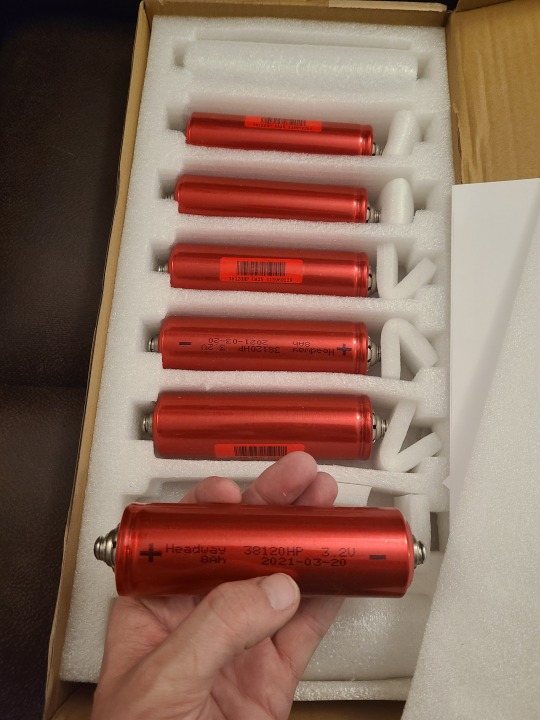
These LiFePo4 batteries can take a beating compared to Li-ion ones. Most importantly, they can be "float" charged, that is, left on the charger 24/7, without worrying about overcharging it and blowing caustic smoke everywhere. This is critical, because I'm attempting a direct drop-in swap for the old lead battery in this UPS, because float charging a lead battery is basically a requirement, and doing that to a Li-ion battery is asking for a fire!
Using a Li-ion pack would require a custom charging circuit, as the UPS's 27.6V is not correct for any configuration of Li-ion, and would either under charge the pack, losing me 50% of my capacity, or overcharge it, and make it explode. It would also have to stop the batteries from being float charged, again to keep the battery from exploding, while fooling the UPS into thinking a battery is still attached so it doesn't beep at me all the time, and my head is spinning just thinking about how that would work. Much easier to give up capacity for a simpler, and more robust battery.
This UPS can deliver 900 watts of power on battery, that equates to roughly 30 amps of current from the 27.6V battery pack. Adding a safety factor, I bought a BMS (Battery Management System) rated to 50 amps. A BMS is essential, as it offers extra protection against short circuits, over and under-charging and temperature cutoff. Also cell balancing, which keeps all the cells at the same level of charge during use (if they go out of sync-that's bad, is all I'll say for now). The batteries are rated for 120 amps continuous draw, so I am well under the limit where the cells would self-immolate.
With all that said, here's the guts:
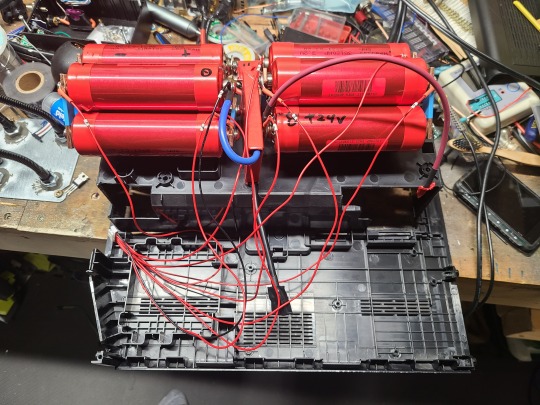
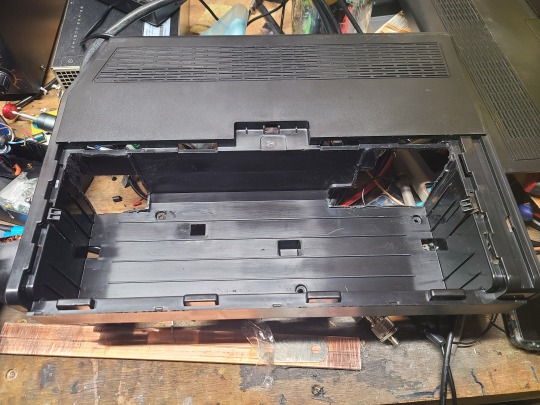

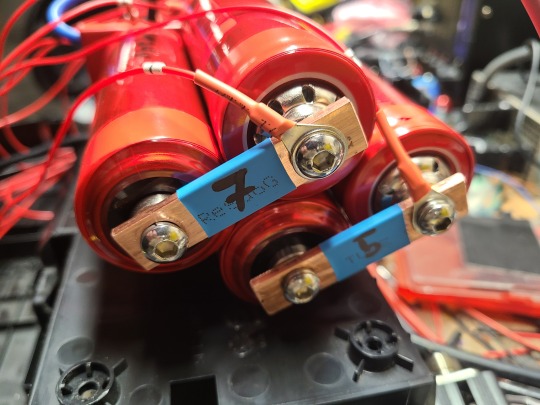

Looking close, you might see that I had to cut some plastic out to make it all fit. That's an error on my part-I didn't measure right. If I make more, I'll definately be using a smaller cell, so it will be a proper "drop in" mod. Lots of drilling, cutting, and filing to make this all fit!
It took several hours to link up the cells, terminate the balancing wires (the small red spindly ones), and and stuff them in the battery box. That's a LOT longer than I was hoping it would take, but the on-the fly mods took a lot of time. but eventually, it all fit in, and I was able to test it:
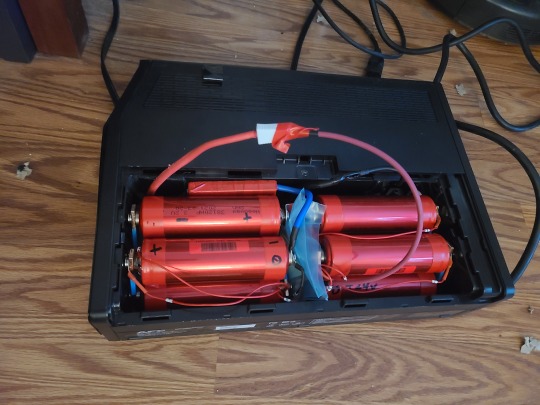
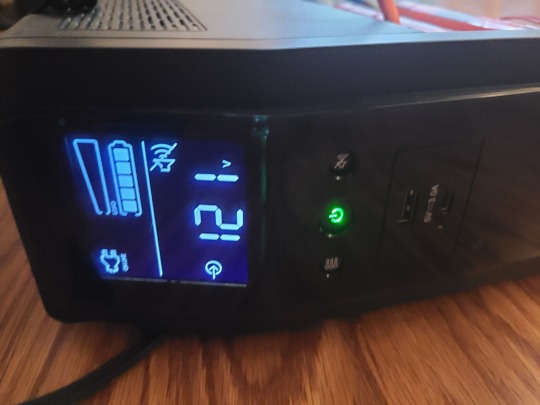
It works! I unplugged it from the wall, and it stayed on! For now, I am in full helicopter parent mode, since I don't want to deal with a lithium fire, even though my math checks out and the UPS should never get the the point that these cells are ever "abused". I only leave it on when I'm in the room, and when I leave, I unplug from the wall, and remove the red lead from the battery, so no charge enters or leaves while I'm not there to watch it.
In theory, the only issue with this retrofit will be a useless runtime meter. The "minutes of runtime" meter is measuring the voltage of the battery as it discharges to estimate how much longer it will last, and the voltage drop over time is different for lithium and lead, so the meter won't be measuring accurately. Once I'm confident it won't explode randomly, I will likely install it permanently somewhere in one of my compters.
Wish me luck!
7 notes
·
View notes
Text
#i had been really excited about getting a solar system with battery backup for our house#a lot less excited after watching that#my thoughts let me tell you them
If it helps, the newer sodium-ion batteries that they have been coming up with in preliminary testing have shown to be much more stable compared to Lithium, even if they aren't able to store as much energy or store it for as long. It's better for the environment and is safer to recycle. Sodium batteries DO preform much better in the cold compared to lithium if that is a concern for you. Thermal runaway is still possible with sodium-ion batteries, but they can't get anywhere near as hot as lithium batteries and the resulting vapor cloud is not as toxic for both people and the environment. It is still in early development so it will take time to see them on the market in the same way that lithium is at the moment, but it's something to keep an eye out for in the future. Esp for energy storage for solar panels.

#personally im keeping an eye on hydrogen vehicles when it comes to environmentally green vehicles#they store as much energy and they preform much better in the cold then lithium Ev's
14K notes
·
View notes
Text
Yukinova – Reliable Lithium Ion Battery for Electric Scooter Performance

Introduction: Powering the Future of Urban Mobility
As electric mobility rapidly transforms the way we commute, choosing the right battery is essential for performance, range, and safety. Among the different battery technologies available, lithium ion battery for electric scooter usage stands out for its superior energy efficiency, lightweight design, and long-lasting power. At Yukinova, we specialize in producing high-performance lithium-ion battery packs that redefine your scooter experience.
Why Lithium Ion Batteries Are Ideal for Electric Scooters
Electric scooters demand a balance between compact size, power output, and longevity. The lithium ion battery for electric scooter applications ticks all the right boxes:
Lightweight and Compact: Lithium-ion batteries are significantly lighter than traditional lead-acid alternatives, making them perfect for two-wheeler EVs.
High Energy Density: This allows scooters to cover more distance on a single charge without increasing battery size.
Fast Charging: Reduced charging time means your scooter is ready to ride in no time.
Long Cycle Life: These batteries can endure hundreds of charge cycles with minimal capacity degradation, giving you more value and reliability.
Yukinova’s Advanced Lithium Ion Battery Technology
At Yukinova, we take pride in being one of India’s leading innovators in EV battery solutions. Our lithium ion battery for electric scooter is designed with cutting-edge features:
Integrated Battery Management System (BMS): Our batteries come equipped with smart BMS that protects against overcharging, overheating, and short circuits.
High-Quality Cell Composition: Only top-grade lithium-ion cells are used to ensure long cycle life and stable output.
Thermal Stability: Yukinova batteries are engineered to perform in India’s diverse weather conditions — from extreme heat to cold.
Customization Options: We offer various voltage and capacity combinations to suit different scooter models and performance requirements.
Benefits of Choosing Yukinova
Performance & Range: Our batteries support longer rides with consistent power delivery throughout the journey.
Durability: With robust casing and advanced internal components, Yukinova batteries are built to last.
Eco-Friendly: Lithium-ion technology supports cleaner mobility with zero emissions and reduced environmental impact.
Certified Safety Standards: Our batteries comply with international safety regulations and are rigorously tested for quality assurance.
Applications Beyond Scooters
While our lithium ion battery for electric scooter solutions are popular, Yukinova also develops battery packs for:
E-bikes and electric cycles
Electric rickshaws
Portable energy storage units
This versatility makes Yukinova a one-stop solution for diverse EV needs.
Conclusion: Ride Smarter with Yukinova
As electric scooters continue to shape the future of smart mobility, the demand for reliable power is growing. Yukinova’s lithium ion battery for electric scooter is engineered to meet these evolving needs with performance, efficiency, and safety. Whether you’re commuting through busy city streets or traveling longer routes, trust Yukinova to power your ride with innovation and reliability.
ORIGNAL SOURCE ;- https://lithiumionbatterysupplier.blogspot.com/2025/06/yukinova-reliable-lithium-ion-battery.html
#lithium ion battery for electric scooter#battery manufacturer#lithium ion batteries#battery supplier#yukinovabattery#lithium ion battery manufacturer
0 notes
Text

Compact and reliable Battery Testing System 120V 50A 4CH designed for accurate performance testing of lithium battery packs. Ideal for multi-channel, high-voltage testing in EV and energy storage applications.
#Battery Testing System 120V 50A 4CH#Multi-channel battery tester#Lithium battery pack tester#Battery testing equipment#High voltage battery tester#EV battery testing system#4 channel battery tester#Battery discharge and charge tester
0 notes
Text
Yasyas eBikes – The Smart, Sustainable Choice for Urban Commuters
As cities become more congested and environmental concerns escalate, the need for efficient, eco-friendly commuting solutions is greater than ever. Yasyas eBikes emerge as the ideal solution—offering a smart, sustainable, and stylish mode of transportation perfectly suited for the modern urban commuter. Whether you're navigating rush hour traffic, covering your daily office route, or running quick errands, Yasyas eBikes combine functionality, convenience, and environmental responsibility in one powerful package.
At the heart of the Yasyas eBike revolution is sustainability. With zero emissions and low energy consumption, these electric bikes help reduce carbon footprints and minimize noise pollution—key concerns in today’s rapidly urbanizing world. By choosing a Yasyas eBike, riders directly contribute to cleaner air and a healthier city environment. It’s an impactful step toward combating the climate crisis while enjoying the freedom of two-wheeled mobility.
But sustainability doesn't mean compromising on performance. Yasyas eBikes are engineered for efficiency, speed, and reliability. Powered by advanced lithium-ion batteries and high-torque motors, these bikes provide seamless acceleration, impressive range, and the ability to conquer urban terrain with ease. Whether it’s steep inclines or long stretches of traffic-filled roads, Yasyas eBikes handle it all while keeping you comfortable and in control.
For the modern commuter, time is money. Yasyas eBikes help save both. With faster commute times, fewer delays, and the ability to bypass traffic congestion, you can make the most of your day. Plus, there's no need to search for parking or worry about fuel costs. Charging a Yasyas eBike is inexpensive and convenient, making it a cost-effective alternative to traditional two-wheelers or cars.
Yasyas also integrates intelligent design into every model. From sleek frames and ergonomic seating to intuitive digital displays and smart features like app connectivity and GPS tracking, these eBikes are made for tech-savvy commuters. Select models even include regenerative braking systems and customizable riding modes to enhance energy efficiency and user experience.
Safety is another top priority for urban riders, and Yasyas delivers here too. Built-in LED lighting systems, anti-skid tires, and responsive braking mechanisms ensure a safe ride even during night commutes or adverse weather conditions. The durable build quality and quality-tested components give every rider confidence, whether you're commuting daily or exploring new parts of your city.
Conclusion: For urban commuters seeking a smarter, cleaner, and more enjoyable travel solution, Yasyas eBikes are the ultimate choice. They’re not just about getting from point A to point B—they represent a lifestyle of efficiency, responsibility, and modern mobility. With cutting-edge features, sustainable performance, and sleek urban appeal, Yasyas eBikes are transforming the future of transportation. Visit yasyas.com to explore the complete range of smart electric bikes and join the movement toward greener cities and better living.
0 notes
Text
Powering the Future: Solar Panels and Battery Systems in Sydney
As energy costs continue to rise and environmental concerns grow, homeowners across Sydney are turning to renewable energy solutions. Among the most popular and effective options are solar panels and battery systems, which together offer long-term savings, energy independence, and environmental sustainability. With the right guidance and support from a professional solar panel installer in Sydney, making the switch to solar has never been easier. From solar panels installation to maintenance and upgrades, Sydney residents have a wealth of options available — especially with new incentives such as the Federal government battery rebate, solar home battery rebate, and the cheaper home battery scheme.
The Growing Popularity of Solar Panels in Sydney
Solar panels Sydney are now a common sight on rooftops across the city. Thanks to abundant sunshine and increasing affordability, solar energy has become one of the most cost-effective ways to power homes and reduce electricity bills. More homeowners are embracing solar panels installation not just for environmental reasons, but also to future-proof their homes against rising grid power costs.
Professional solar panel installation Sydney services ensure that systems are tailored to each home’s size, orientation, and energy needs. With correct installation, homeowners can achieve maximum energy efficiency and faster returns on investment.
Finding the Right Solar Panel Installer in Sydney
Choosing the right solar panel installer Sydney is crucial for a successful solar energy system. A trusted and experienced installer will assess your property, recommend suitable products, and ensure the installation complies with Australian safety and quality standards. They will also help navigate rebates, permits, and offer ongoing support.
Top-rated solar power providers in Sydney not only handle the installation but also offer ongoing support, including solar panels maintenance and repairs, to ensure the system runs efficiently over time.
Importance of Solar Panels Maintenance
Once installed, solar panels maintenance Sydney becomes essential to ensure optimal performance. Dust, leaves, bird droppings, and other environmental factors can reduce panel efficiency. Professional solar repair and maintenance Sydney services can diagnose and fix issues quickly, helping homeowners avoid loss of energy output and expensive repairs.
Most maintenance services include visual inspections, performance testing, and cleaning. Regular check-ups can also detect any faults early, extending the lifespan of both the panels and the battery systems Sydney homeowners rely on for storage.
Battery Systems in Sydney: Maximising Your Solar Investment
Solar panels generate electricity during the day, but energy needs often extend beyond sunlight hours. That’s where battery systems Sydney come in. These systems store excess solar energy for use at night or during grid outages, providing energy security and maximising the value of your solar installation.
Home solar battery installation Sydney is rapidly growing in popularity, thanks in part to technological advancements and attractive government incentives. High-capacity lithium batteries are now more affordable and reliable than ever, making them a smart investment for energy-conscious households.
Government Rebates and Financial Incentives
To accelerate the shift toward renewable energy, both federal and state governments have introduced various financial incentives. The Federal government battery rebate helps lower the upfront cost of installing a home battery, making it more accessible to average homeowners.
Similarly, state-level initiatives like the cheaper home battery scheme and solar home battery rebate are designed to further reduce financial barriers. These schemes aim to encourage widespread adoption of solar and battery technologies by subsidizing eligible systems and installations.
Navigating these rebate programs can be complex, but a reputable solar power provider Sydney can offer expert guidance. They often help with application submissions and ensure your system meets all eligibility requirements.
Advantages of Combining Solar Panels with Home Batteries
Pairing solar panels Sydney with battery systems Sydney offers numerous benefits. Firstly, it provides energy independence. Homes with battery storage can operate off-grid for significant periods, reducing reliance on traditional utilities. Secondly, it leads to significant cost savings. With stored energy, homeowners can avoid peak electricity rates and even sell excess energy back to the grid in some cases.
Lastly, combining solar panels and batteries supports environmental sustainability. Every kilowatt-hour generated from the sun reduces the need for fossil fuels, cutting carbon emissions and helping fight climate change.
Challenges and Considerations
Despite the many benefits, there are still challenges to consider. Initial costs, although falling, can still be a barrier without rebates. Some older properties may need electrical upgrades to accommodate new systems. Additionally, homeowners must be aware of their energy consumption habits to choose the right battery size.
That’s why working with an experienced solar panel installer Sydney is vital. They’ll assess not only your roof but your household's energy profile, recommending the best battery systems Sydney has to offer in line with rebate programs and long-term savings potential.
Future of Solar Power in Sydney
With increasing awareness and expanding incentive programs, the future of solar in Sydney looks bright. Emerging technologies like virtual power plants, smart inverters, and peer-to-peer energy trading are also transforming how solar energy is used and shared.
The role of professional services in solar repair and maintenance Sydney, installation, and monitoring will become even more important as systems grow more advanced. This means homeowners will increasingly rely on solar power providers Sydney to maintain and upgrade their setups for optimal performance and cost-effectiveness.
Conclusion
In summary, solar panels Sydney and battery systems Sydney represent a powerful and sustainable solution for modern energy needs. With proper solar panel installation Sydney, regular solar panels maintenance, and strategic use of available incentives such as the Federal government battery rebate, cheaper home battery scheme, and solar home battery rebate, homeowners can drastically reduce their energy bills and carbon footprint.
Whether you're just starting to explore renewable energy or ready to install a full solar and battery system, partnering with a trusted solar panel installer Sydney is the key to a smooth, successful transition to cleaner, cheaper power. With the right support and smart planning, solar energy can be a lasting investment in your home, your wallet, and the planet.
#sustainableliving#sustainableenergy#solar#solar battery#solar installation sydney#batteryrebate#federal rebate
0 notes
Text
Comprehensive Lithium Manufacturing Plant Project Report by Procurement Resource
Procurement Resource, a global leader in procurement intelligence and market research, proudly presents its latest report on the Lithium Manufacturing Plant Project Report. This extensively researched and meticulously curated report offers an actionable roadmap for entrepreneurs, investors, and stakeholders seeking to enter the fast-growing lithium market. It covers critical factors such as industry trends, plant setup, production processes, raw material requirements, cost estimation, and financial modeling—essential components for launching a competitive lithium manufacturing unit.
Lithium: Powering the Future of Energy
Lithium, a lightweight and highly reactive alkali metal with the chemical symbol Li, has become indispensable in the modern industrial and technological landscape. It is a key component in lithium-ion batteries, which power everything from smartphones and electric vehicles (EVs) to renewable energy storage systems. Its applications extend into pharmaceuticals, aerospace alloys, ceramics, and lubricating greases, underscoring its versatile industrial importance.
The exponential growth in electric mobility, energy storage systems, and sustainable technologies has propelled lithium into the spotlight, making it one of the most sought-after commodities in the global market. As governments and corporations push for decarbonization and green energy adoption, the demand for lithium is set to soar over the next few decades.
Strategic Insights from the Lithium Manufacturing Plant Report
Procurement Resource’s report delivers a deep dive into the end-to-end process of establishing a lithium manufacturing facility, offering key data, trends, and practical guidance necessary for business success.
Market Analysis:
Global Demand Dynamics: Driven by the surge in EV manufacturing and renewable energy storage solutions, lithium demand is growing at a compound annual growth rate (CAGR) of over 12%. Asia-Pacific, led by China and South Korea, dominates global consumption, while North America and Europe are expanding capacity to reduce import dependence.
Price Trends: The report includes a detailed price analysis of lithium carbonate, lithium hydroxide, and other derivatives, tracking market fluctuations based on supply-demand shifts, mining regulations, and geopolitical factors.
Competitive Landscape: Profiles of leading producers, regional supply chain mapping, and market segmentation provide an understanding of the competitive ecosystem and potential entry points.
Technical and Operational Insights:
Manufacturing Process Overview:
The report outlines two primary methods of lithium production:
Hard Rock Mining (e.g., Spodumene ore processing)
Lithium Brine Extraction (from salt flats or underground reservoirs)
Each method includes stages such as:
Mining and raw material extraction
Concentration and purification
Conversion to lithium carbonate or hydroxide
Drying, packaging, and quality testing
Machinery and Equipment:
A comprehensive list of machinery required for the lithium manufacturing plant is included:
Crushers, grinders, and flotation units (for hard rock processing)
Evaporation ponds, solvent extraction units, and ion exchange systems (for brine processing)
Kilns, leaching tanks, crystallizers, centrifuges, dryers, and packaging systems
Options for manual, semi-automatic, and fully automatic setups are compared based on operational scale and capital investment.
Infrastructure & Utilities:
Land & construction: Ideal layout design based on capacity
Power and water supply: Energy-intensive units require robust utility infrastructure
Waste treatment and emissions control: Meeting environmental compliance
Workforce planning: Skilled labor and technical staff requirements
Financial and Economic Assessment:
The report includes a highly detailed financial feasibility analysis, covering:
Capital Investment: Cost of land acquisition, plant construction, machinery, licenses, and initial inventory
Operating Costs: Utilities, raw materials, labor, maintenance, environmental compliance, and logistics
Revenue Streams: Projections for primary and by-product revenues
Break-even Analysis: Timeline to reach profitability based on production capacity and market prices
ROI Estimates: Long-term profitability outlook with sensitivity scenarios
These insights help entrepreneurs identify the best-suited production model—whether small-scale, modular plants or large-scale industrial operations.
Sustainability and Industry Trends
Green Lithium and Environmental Compliance
Amid growing environmental concerns, the lithium industry is evolving toward sustainable extraction and cleaner processing technologies. Some key trends highlighted in the report include:
Direct Lithium Extraction (DLE): A newer method that significantly reduces water usage and land disruption
Recycling and Circular Economy: Efforts to recover lithium from spent batteries are gaining traction, especially in Europe and North America
Eco-friendly Brine Processing: Solar evaporation and closed-loop systems are replacing older, resource-intensive methods
Government Incentives and Regulations: Policies such as the U.S. Inflation Reduction Act and EU Battery Directive are shaping greener supply chains and incentivizing local production
Why Choose Procurement Resource?
With years of industry experience and a team of dedicated researchers and analysts, Procurement Resource provides the critical intelligence businesses need to make data-driven, strategic decisions. The lithium manufacturing plant report exemplifies the firm’s commitment to delivering actionable, practical, and forward-looking insights.
Key Deliverables from the Report:
Step-by-step guide to lithium plant setup
Market and pricing intelligence for lithium derivatives
In-depth cost analysis for plant design and operations
Regional and global demand forecasting
Risk assessment and regulatory compliance guidelines
Financial modeling and profitability scenarios
Whether you are a startup seeking funding, a multinational planning to expand operations, or an investor scouting high-growth opportunities, this report offers a turnkey business blueprint.
Request a Free Sample Report
Entrepreneurs and investors interested in launching or scaling a lithium manufacturing unit can request a complimentary copy of the full report. Gain early insights into one of the fastest-growing industrial sectors and make informed, profitable business decisions.
Request a Free Sample Report: https://www.procurementresource.com/reports/lithium-manufacturing-plant-project-report/request-sample
About Procurement Resource
Procurement Resource is a trusted global provider of procurement intelligence, market research, and supply chain consulting. The company empowers businesses through:
Cost modeling and benchmarking tools
Comprehensive market research and pricing databases
Supply chain optimization and sourcing strategies
Real-time procurement analytics and forecasting
With a global presence and industry-specific expertise, Procurement Resource ensures that clients remain agile, competitive, and profitable in an increasingly dynamic market environment.
Contact Information
Company Name: Procurement Resource Contact Person: Ashish Sharma (Sales Representative) Email: [email protected] Location: 30 North Gould Street, Sheridan, WY 82801, USA Phone: UK: +44 7537171117 USA: +1 307 363 1045 Asia-Pacific (APAC): +91 1203185500
0 notes
Text
Powering Kerala’s Energy Future: Leading Lithium-ion Battery Manufacturer in Kerala
As the demand for cleaner, smarter, and more efficient energy solutions rises, lithium-ion batteries have emerged as the backbone of modern power systems. Whether it’s driving electric vehicles (EVs), storing solar energy, or supporting uninterrupted power supply for homes and businesses, lithium-ion technology is transforming how Kerala manages electricity. At the forefront of this energy revolution is a trusted lithium-ion battery manufacturer in Kerala, dedicated to delivering unmatched performance, safety, and reliability.
Why Lithium-ion Batteries?
Lithium-ion batteries are known for their:
High energy density
Fast charging capability
Long lifecycle
Lightweight design
Low maintenance needs
These qualities make them ideal for a wide range of applications, from personal electronics and solar inverters to electric vehicles and large-scale energy storage systems. For a state like Kerala—where green energy adoption and EV usage are rapidly expanding—lithium-ion batteries offer a sustainable power solution.
Driving EV Growth in Kerala
Kerala is one of India’s most progressive states when it comes to electric mobility. With government initiatives supporting EV infrastructure and subsidies for electric vehicles, the need for reliable battery solutions is more critical than ever. A reputed lithium-ion battery manufacturer in Kerala ensures that local EV manufacturers and service providers have access to advanced batteries designed specifically for Indian terrains and climatic conditions.
Advertisement
These batteries are engineered to withstand Kerala’s coastal humidity, high temperatures, and heavy rains, offering consistent performance and safety in every journey.
Empowering Solar Installations
The state’s push towards renewable energy has also increased the demand for efficient solar power systems. Lithium-ion batteries play a key role in storing solar energy for night-time or backup use. Our high-efficiency batteries:
Support deep discharge cycles
Offer smart battery management systems (BMS)
Deliver superior charge retention
Require minimal maintenance
For homeowners, schools, and businesses investing in solar energy, choosing a lithium-ion battery manufacturer in Kerala that understands local energy needs can make all the difference.
Built for Harsh Indian Conditions
Our lithium-ion battery solutions are designed to handle the extremes—be it high temperatures, frequent power outages, or fluctuating energy loads. From remote rural setups to modern urban buildings, our products cater to a variety of power demands. As a leading lithium-ion battery manufacturer in Kerala, we ensure every unit is quality-tested, eco-friendly, and equipped with the latest safety features.
Commitment to Sustainability and Innovation
Innovation drives our mission. We continuously invest in R&D to improve battery efficiency, safety protocols, and environmental performance. Our sustainable manufacturing processes reduce carbon footprints and align with Kerala’s eco-conscious development goals.
Conclusion
Whether you’re powering an electric scooter, installing a solar backup, or building a smart home, our lithium-ion batteries provide dependable energy you can trust. As a premier lithium-ion battery manufacturer in Kerala, we are proud to support the state’s journey toward a cleaner, smarter, and more resilient energy future.
Original Source:- https://fuzebattery.blogspot.com/2025/06/powering-keralas-energy-future-leading.html
0 notes